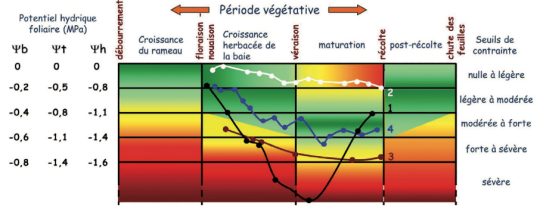o Proactive irrigation: this is implemented to prevent severe water stress before the observation of any visual symptoms. This strategy seems less risky but can also lead to high water consumption and/or excessive vigour and more virulent fungal attacks, especially after unforeseen heavy rain.
o Corrective irrigation: in this case, the risks are quite different and can be irreversible, a lack of water can affect vines in different ways depending on the stage in the growth cycle. For example, a lack of water during the flowering-setting period can strongly impact the setting rate and drastically reduce the yields.
At Eisele Vineyard, proactive irrigation is favoured. The effectiveness depends on the stage at which water is provided in anticipation of stress. Before and during véraison, it is a means of combating severe stress. After véraison, it enables the consequences of very dry weather to be reduced.
Several irrigation strategies exist: it is possible to irrigate at night in order to reduce water loss through evaporation. During very dry winters, it is also possible to only irrigate between the end of the harvest and the budburst, throughout the winter period, in order to replenish the soil's useful water reserves. Irrigation can be annual or on a one-off basis in years when heatwaves occur. At Eisele Vineyard, high-quality grapes are produced through irrigation on an occasional basis.
In all cases, irrigation is most effective when it respects the vines' water requirements.
Irrigation can be managed, as in this example, by measuring leaf water potential throughout the ripening process.

